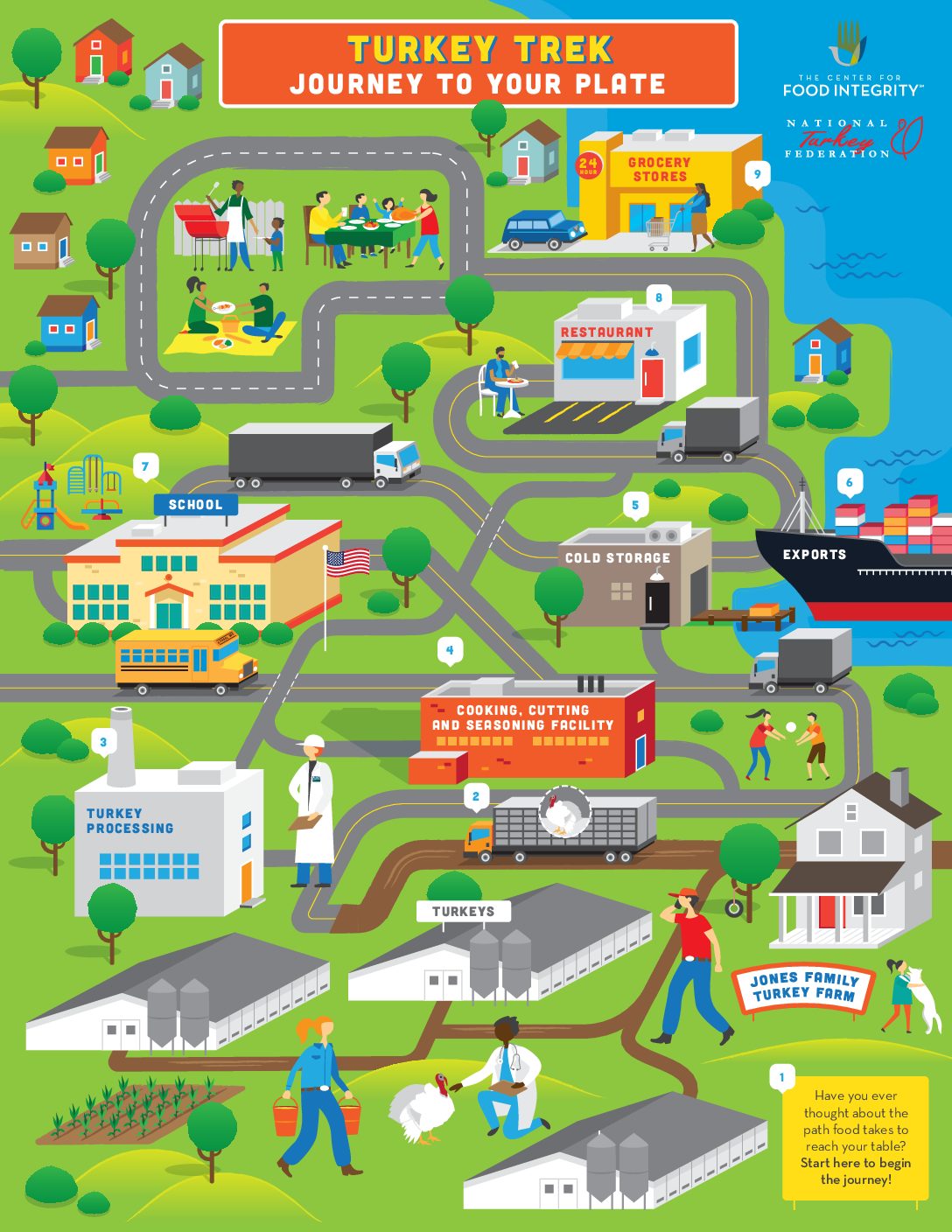
Turkey Trek: Journey to Your Table
05/14/2020
Whether it’s a succulent roasted turkey at Thanksgiving, marinated turkey tenderloin on the grill or a salad topped with turkey slices, turkey plays a starring role as a lean and tasty protein source for today’s consumers. Delicious, versatile and available in a variety of cuts, turkey is naturally low in fat and provides immune-boosting nutrients such as iron, zinc and B vitamins. As a complete protein, turkey helps people feel full longer and satisfy their appetite for healthy eating.
To bring you the versatility, convenience and value of turkey, the U.S. turkey industry safely and reliably processes, packages and delivers a variety of products every day to the roughly 40,000 grocery stores and 650,000 food service facilities across the country. Nearly 450,000 men and women are involved in turkey production to feed approximately 326 million Americans.
Road Trip!
The National Turkey Federation and The Center for Food Integrity have taken a closer look at all the steps that are involved in the food supply chain for turkey. Learn more about the supply chain for meat and poultry.
The turkey we eat begins on the farm where farmers, their families, employees and a team of experts, such as veterinarians, agronomists and nutritionists, work together to feed and raise healthy animals. The U.S. is home to two million farms of all kinds producing the food we enjoy each day.
- Turkey Farms: Each year about 240 million turkeys are responsibly raised on approximately 2,500 farms across the U.S. Turkey production directly employs nearly 450,000 people in the U.S. on farms, in processing facilities and through related industries such as distribution and equipment manufacturing. Farmers raise turkeys with care by providing constant access to food and water as well as shelter to protect the flock from extreme weather and predators. Veterinarians help farmers take care of their turkeys. Just like people, turkeys can get sick, so vets oversee treatment to keep flocks healthy.
- Transport: Specially designed trucks carefully and safely transport turkeys from farms to processing facilities for harvesting into whole birds or a variety of cuts.
- Processing: Across the U.S., turkey processing facilities harvest turkeys in preparation for consumption. USDA’s Food Safety and Inspection Service (FSIS) ensures that our nation’s turkey supply is wholesome, safe and properly labeled. USDA relies on science to continuously improve safety standards. The turkey industry’s top priority is food safety, and companies follow USDA standards throughout turkey processing and packaging.
- Cold Storage: Think of this like a large freezer. These locations safely store meat products frozen until the supply chain needs them. Cold storage facilities are critical to food safety and food security. Turkey products, like fruits and vegetables, are highly perishable and temperature sensitive. Products in cold storage can be stored until needed, then used to fill demand around the country or for export markets.Cooking, Cutting and Seasoning: Beyond the facilities that process turkeys into meat, a number of turkey companies specialize in preparing the vast variety of turkey products we enjoy today. This includes activities such as deboning, creating specialty cuts and smoking or cooking to meet many consumer taste preferences. These products may also involve seasoning, sauces and marinating, as well as special packaging to meet market demands for convenient products. Turkey provides many versatile and flavorful menu items for restaurants, custom cuts for retail grocery stores and healthy items for schools and hospitals.
- Exports: People around the world enjoy U.S. turkey. The U.S. exports approximately 639 million pounds of turkey meat every year. Many export markets enjoy parts of the turkey not often desired by American consumers, such as turkey paws (the feet of the turkey).
- Service Institutions: We often think of eating at home or grabbing a bite from our favorite restaurant. But don’t forget about other businesses such as hospitals, schools, colleges, retirement homes, military bases and event centers that also prepare and serve turkey. The turkey supply chain is not a straight line, rather it is an intricate web that distributes turkey through numerous channels daily.
- Restaurants: The U.S. has more than 650,000 food service facilities across the country. This includes all forms of away-from-home eating such as quick-service restaurants, cafes, fine dining, take-out and catering/delivery services.
- Grocery Stores: Whether shopping online or in store, consumers rely on grocery retailers to provide a selection of healthy and affordable turkey products. Consumers can find turkey in the fresh meat case, the frozen food aisle, the deli counter and in other food products such as soups, snack sticks and frozen entrees.
It takes a vast network of nearly 450,000 men and women to safely and reliably produce, process, package and deliver the delicious turkey that we enjoy throughout the year.

























